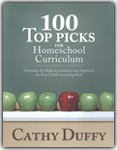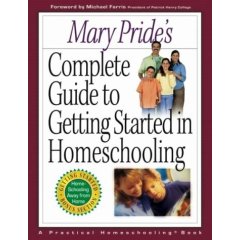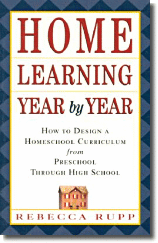Choosing Teaching Materials
Where to begin?
Choosing what you're going to use to home school your children with next fall can be an intimidating task, first because if you're like me, you're already swamped and the last thing in the world you want to do right now is think about what you are going to do about school. Second, because there is so much out there to choose from.
There are so many excellent products available and each one claims to be superior to all others, so it's really hard to decide about a product without actually seeing it . And even then, you don't really know how it works for your family until you actually use it.
But before you actually start looking at products, I'd advise that you revisit some of the basics of what your educational philosophy is, what your family is like, and what teaching and learning styles you have to work with. You can find information about each of those topics in the left column of this page.
I know that it takes some experience to determine which materials are best suited to your teaching style and your children's needs, but I am also convinced that the Lord can lead concerned parents to the teaching materials and methods that work best for their family. Here are some suggestions concerning choosing curricula:
10 Rules of thumb for choosing teaching materials
Rule #1: Invest in yourself first. Like it or not, you are the glue that will hold this home schooling endeavor together, so you need to develop a strategy for staying sane and on top of it all (even if it means scheduling a nap every afternoon). You wouldn't dream of trying to build a house without a plan, the right materials, and the necessary tools. Home schooling is like building a house--you need to determine your plan, gather your materials, and be sure you have the right tools for the job. Take some time to read, to look around, to compare. Invest in some of the "tools of the trade" like the "must haves" and parent resources listed in this ejournal.
Begin rearranging your house so it will accommodate study without becoming too cluttered or stressful. Think through what you will do with infants and toddlers during school times; how you will handle meals, house cleaning, and laundry; and how you will deal with the other changes schooling at home brings.
Don"t feel guilty about spending money on yourself. After all, if you were a professional teacher, you (or your parents) would have spent tens of thousands of dollars getting you ready to stand before a classroom of children. So think in terms of what will make you more confident and able to create a learning environment for your household. What will smooth your way mentally, emotionally, physically, and spiritually?
Rule #2: Consider your situation. A farm family will have many opportunities for "hands on" learning in the areas of math, science, economics, etc. A city family has access to museums, libraries, cultural events, and more support group activities. You can make the most of the real life learning opportunities God gives you, perhaps never needing textbooks and teaching materials in certain subject areas.
I once had a missionary call me bemoaning the fact that she lived in a large foreign city and her children weren't able to do much nature study. She completely overlooked all the wonderful opportunities her children had to learn foreign languages, history, and geography, and to interact with other cultures. So, look around. God may have already arranged a learning environment for you that is better than a classroom.
Rule #3: Choose teaching materials that compliment the learner. Textbooks developed for classroom use tend to be "teacher directed" and chalkboard oriented, seldom taking into account children's interests or of the different ways children perceive and process information. Each student has a style in which he learns best.
Different children have different learning strengths and weaknesses that the perceptive parent will take into account when choosing teaching materials. For example, visual learners may do well with workbooks, while auditory learners need songs or spoken instruction and kinesthetic learners need to manipulate objects. (In a future ejournal we will discuss different learning styles and preferences.)
Rule #4: If you don't like the material, you will resist using it no matter how good it is. All teaching materials have a bias, not just in the subject matter, but also in the way the subject matter is presented. Every teaching parent, whether he or she recognizes it or not, has an educational philosophy--some set of values and beliefs about what and how children should be taught.
Sometimes we will have an unexplained inner resistance to certain teaching materials. It could be that this inner resistance arises from a conflict between our educational philosophy and that of the teaching material.
Trust the Holy Spirit and choose from your spirit as well as from your head. No matter how much your friends rave about a particular product, don't buy it if you don't really like it yourself. A key question to ask is: "Does just looking at this curriculum make me feel tired or pressured?" Your body knows what's good for you. Listen to it.
Rule #5: Avoid programs that require a great deal of teacher preparation. Unless you are a researcher-type or high-energy person, you will be frustrated by programs with detailed teacher's manuals to wade through, supplemental books or seminars that are necessary to fully utilize the program, or lots of activities to prepare beforehand.
Rule #6: Expect to waste time, energy, and especially money. You will soon discover that often it is you, not your children, who are being educated. So loosen up and accept the fact that some of what you buy will be a total waste of time, energy, and money. This is all a part of learning what works for you and for your children. Consider it payment of your tuition in the University for Home Educating Parents .
Rule #7: Be aware that there are various schools of thought concerning the teaching of any subject. Some examples: In math there are programs that are primarily problem solving with manipulatives and programs that are primarily problem solving on paper. In reading there are programs that focus on learning phonics before learning to read, programs that focus on learning the rules while learning to read, and programs that focus on just learning to read and letting the rules come later.
Each school of thought has produced excellent mathematicians, readers, and spellers, but sometimes products will be advertised as better than the rest because they follow a particular school of thought.
Rule #8: Realize that there is no perfect curriculum. What works with one child won't necessarily work with another. What worked one year may not necessarily work the next. Your family's needs and interests will change. Buy materials that meet present needs. Mold the curriculum to the child, not the child to the curriculum.
Also, be aware that not all books in a series are equally as good. For example, the fourth grade level of a particular program may be excellent, but this does not mean the other levels are.
Rule #9: God gave you YOUR specific children because there is something in YOU that He wants imparted to them. Teaching materials are only tools to help you impart yourself to (disciple) your children. You can trust the Lord to lead you to those materials that will help you best disciple each child.
Rule #10: Remember that teaching materials are often the least important elements of your home school. Books are easy to discard if they don't work for you, but attitudes and destructive family dynamics are not. According to a survey of home schooling families, five major reasons families fail at home education are: (1) they lack the personal conviction to persevere through the difficult times; (2) the father is not involved; (3) the children are undisciplined and resist parental instruction; (4) the parents cannot handle the added responsibilities; and (5) the family has unrealistic expectations.
The best teaching materials in the world are going to take a back seat to the attitudes and family dynamics in your household.
Tips for Actually Looking at the Stuff You're Thinking About Buying
1. There are a few retail stores that cater to homeschoolers. If you are lucky enough to have one of these nearby, camp out there one afternoon.
2. Ask the members of your local support group if you could look through the materials that they use. Some larger support groups even have "libraries" of teaching materials.
3. Many vendors now have home pages on the web. Some provide very little information, such as a picture, the number of pages, and the price. A few provide an overview along with the table of contents.
4. Ask questions about specific materials in one of the homeschooling newsgroups or chat rooms.
5. Collect catalogs. Unfortunately, these will give you pictures and prices but not much else.
6. Go to a curriculum fair. Contact your state associations to see when there is one in your area.
7. You may be able to preview materials using interlibrary loan at your local library. This is useful if you have a particular textbook in mind.
8. For high-schoolers, visit your local college or university bookstore near the beginning of the semester and have a look around at the teaching materials.
9. Find a school supplies store. They will often carry teaching materials you won't see in home school catalogs.
Essential Resources for Choosing Teaching Materials
 100 Top Picks for Homeschool Curriculum by Cathy Duffy. Selecting the right curriculum can be a time consuming task for any family that chooses home education. Now, Cathy Duffy makes choosing the right resources for your child easy! 100 Top Picks for Homeschool Curriculum by Cathy Duffy. Selecting the right curriculum can be a time consuming task for any family that chooses home education. Now, Cathy Duffy makes choosing the right resources for your child easy!
I've always recommended Cathy's curriculum guides as the best out there for choosing teaching materials that "mesh" with who your family is. Now Cathy guides you through the process, offering her "Top Picks" from each subject area.
A major feature of 100 Top Picks is the charts showing the 100 Top Picks in relation to educational approaches, learning styles, and practical features such as prep time needed; design for independent, one-on-one, or group learning; and ease of use for the teacher. Complete reviews of each of the Top Picks provide parents the information they need to make the best choices for each of their children.
The first half of 100 Top Picks covers information that will help you decide your child's learning styles, help you decide what your "Philosophy of Education" is, and help you figure what to teach when. The second half has reviews for all 100 of the top picks. You will gain a lot of insight into what curriculum is available by reading these reviews. She even tosses some extra "Picks" here and there that would've made the list if her books title was "200 Top Picks".
 Mary Pride's Complete Guide to Getting Started in Homeschooling. The title can be deceiving, because the book isn't just for those getting started, it's also very helpful to veteran home schoolers who want to re-evaluate what they are doing and the resources that are available to them. Mary Pride's Complete Guide to Getting Started in Homeschooling. The title can be deceiving, because the book isn't just for those getting started, it's also very helpful to veteran home schoolers who want to re-evaluate what they are doing and the resources that are available to them.
Veteran home educators will dive into a vast amounts of up-to-date information with sections on Field Trips, Conferences, Retreats & Homeschool Days for the Whole Family, and Worldview & Leadership Training for Teens. There's also information on how to find everything from contests, to how to write a winning college application essay.
If there were one "top expert" in homeschooling, I would say Mary Pride is it. With her numerous books, Practical Homeschooling Magazine, and website, Mary knows her stuff.

Home Learning Year by Year: How to Design a Homeschool Curriculum from Preschool Through High School by Rebecca Rupp. This book does not come from a Christian orientation, but is one of the few books I know that gives you a checklist of what the traditional pre-K through 12th-grade curriculum expects a child to learn year by year and then tells you how to accomplish the same level of learning at home. Home Learning Year by Year also gives guidelines for the importance of each topic, pointing out which knowledge is essential and which is best for more expansive study based on your child's personal interests.
Any article appearing on this website may be copied or forwarded electronically provided that proper credit is given and that the article is not substantively modified.
No article may appear in whole or in part in a publication sold for profit or as part of any commercial endeavor without the written consent of Home School Marketplace.
© Copyright 2006. Home School Marketplace, 1053 Eldridge Loop, Crossville, TN 38571.
Be sure to sign up for our ejournal!
Sign up below.
View past ejournals HERE>> |

 100 Top Picks for Homeschool Curriculum
100 Top Picks for Homeschool Curriculum Mary Pride's Complete Guide to Getting Started in Homeschooling.
Mary Pride's Complete Guide to Getting Started in Homeschooling. 